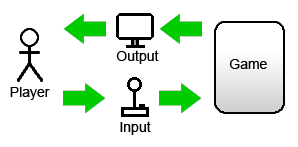Trending
Opinion: How will Project 2025 impact game developers?
The Heritage Foundation's manifesto for the possible next administration could do great harm to many, including large portions of the game development community.

Featured Blog | This community-written post highlights the best of what the game industry has to offer. Read more like it on the Game Developer Blogs or learn how to Submit Your Own Blog Post
Some people refuse to see that story-driven games can be fun to play and interactive. Let's focus on the story interactivity cycle in order to fix some issues about interactive storytelling.

Some people refuse to see that story-driven games can be fun to play and interactive.
“Games can’t be stories because they’re interactive”.
Wrong. Let’s rephrase it so we can improve our game stories.
“Games can tell many different stories because they’re interactive”.
Games are interactive. The players throw some inputs to the game system, and it changes accordingly, displaying some output back to the players. This is the game’s interactivity cycle.

Figure 1: Game interactivity cycle
Figure 1: Interactivity cycle of games.
Most story-driven games can’t cope with interactivity. The player inputs don’t affect the game story, and the story outputs are shown in either case. No matter what the player does, the story follows its linear path. As a result, the story is conveyed linearly without player’s interaction. Feeling no control over the story, the player loses interest in the game story, which becomes a secondary game asset.

Figure 2: Broken story interactivity cycle
Figure 2: Broken interactivity cycle of story games.
But still players love stories. Players want to play their own stories. In order to achieve this interactive storytelling in games we need to follow the game’s interactivity cycle. The player throws some inputs and the story changes, displaying some outputs back to the player.

Figure 3: Story interactivity cycle
Figure 3: Interactivity cycle of story games.
The issue begins with the absence of inputs that affect the story. A typical story-driven game has lots of inputs that affect gameplay (move, shoot, cast spell, talk to NPC, etc). But there’re no specific story inputs. Two solutions arise:
Sometimes, interactive storytelling is just a matter of using gameplay inputs in order to drive the story. In other words, using gameplay inputs to fix the story interactivity cycle. Let’s see an example. We have a typical linear story-driven game. After completing some gameplay challenges, the game conveys a static story fragment. Using the player’s gameplay data we can do some checks. Did the player kill lots of enemies? Maybe it’s a hardcore killer. Did the player talk many times with NPCs? Maybe it’s more in the mood for conversation. Which NPC is the player speaking more frequently? Maybe it’s the player’s favorite NPC. Hold on. We’ve found an interesting story event. Instead of conveying a static story fragment now we can convey a dynamic story fragment using this valuable data. Instead of killing always Aeris now we can kill the player’s favorite NPC, which sometimes will be Aeris and sometimes will be another NPC.
Interactive storytelling is just a matter of giving some choices so the player can drive the story. In other words, adding story inputs to fix the story interactivity cycle. Let’s see another example. We have a typical linear story-driven game. The story features a good girl and an evil girl. The player character falls in love with the good girl, and the evil girl becomes the shadow. Hold on. The player’s not doing anything. There’s no choice to make. Why don’t we make both girls available to the player? The player character chooses to fall in love with the good girl or the evil girl. Then, the refused girl becomes the shadow. Much more interactive.
It doesn’t matter which inputs you choose in the story interactive cycle as long as the player is interacting, in control of the story.
Gameplay inputs tend to be more long-termed. The story evolves as a result of the player’s gameplay history, feeling that the player’s not in direct control. The gap between the player input and the story output is so wide that it becomes difficult to relate gameplay action and story consequence.
On the other hand, story inputs tend to be more short-termed. The story evolves as a result of a concrete player’s choice, feeling that the player’s always in direct control. Such a narrow gap between the player input and the story output may result in a loss of character coherence.
Somewhere in the middle we can find a compromise solution where both game and story interactivity work together for the benefit of the player’s diversion and immersion.
Read more about:
Featured BlogsYou May Also Like